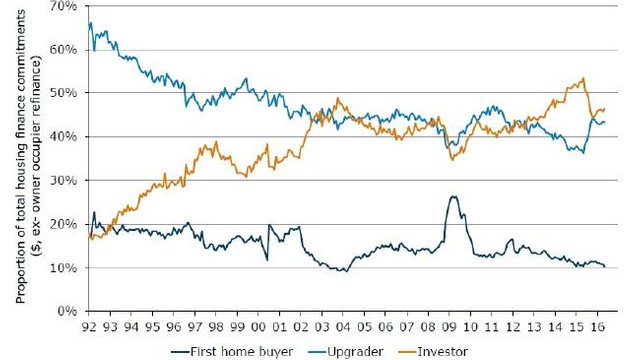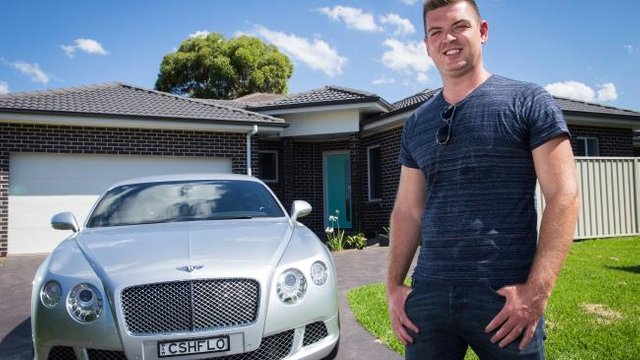First-home buyers are becoming ‘rentvestors’

ARE first-home buyers an endangered species?
Data released this week by the Australian Bureau of Statistics definitely paints a bleak picture of the Great Australian Dream.
According to the latest housing finance data released on Monday, the proportion of first-home buyers as a share of total home loans has fallen to its lowest level in more than a decade.
First-home buyers made up just 10.2 per cent of all home loans in May. As a proportion of owner-occupier finance commitments, first home buyers fell to 13.9 per cent, down from 14.4 per cent in April.
New lending for investor housing, meanwhile, bounced back 3.9 per cent in a near-complete reversal of a fall in April. Investors made up 46.5 per cent of all finance, with upgraders just behind at 43.3 per cent.
Investor demand remains strong, despite a recent tightening of lending criteria by the prudential regulator pouring cold water on the market.
By all accounts, first home buyers are struggling to compete.
“Affordability continues to weigh on this segment of the market,” ANZ economist Daniel Gradwell notes.
“Demand for housing remains solid, evidenced by a number of other indicators such as rising prices, buoyant auction clearance rates and resilient building approvals.”
But here’s the catch: the ABS data doesn’t tell the whole story, because the ABS narrowly defines first home buyers as owner-occupiers. First time investors have been excluded from the data since 2014.
And according to experts, first home buyers who own an investment property while renting somewhere else — “rentvestors” — are a rapidly growing proportion of the market.
Like Pokemon, first home buyers are evolving.
“The numbers from the ABS aren’t capturing the whole picture of the first-home buyer market,” said Matthew Tiller, head of research at LJ Hooker.
In a report released last week, the real estate firm found investors with household income under $100,000 made up the largest group (38 per cent) of rentvestors, and more than two thirds (67 per cent) only own one investment property.

Property guru Nathan Birch, a pioneer “rentvestor”. Picture: Jonathan Ng
Property guru Nathan Birch, a pioneer “rentvestor”. Picture: Jonathan NgSource:News Corp Australia
“Primarily it’s driven by affordability constraints and lifestyle choices,” Mr Tiller said. “People rent where they want to live and purchase where they can afford to — it’s just savvy buyers adapting to the circumstances.”
When LJ Hooker identified the trend in 2013 — it has even taken out a trademark on the term — it was described as a “young couple in their late 20s or early 30s who love their lifestyle and don’t want to relocate from where they were renting”.
According to the latest survey, however, there are now two clear categories: those driven by lifestyle choices and affordability constraints, and the second category who are driven by work, study or other personal circumstances.
The survey found 56 per cent of rentvestors are now aged between 35 and 55, and 43 per cent are doing so due to work or study.
Ricky Briggs, 24, is one of the new breed of first homebuyer. The young professional, highlighted in LJ Hooker’s research, rents in Sydney but owns a property just south of Newcastle in the Lake Macquarie area.
Mr Briggs, who rents in Sydney’s inner west, saw an opportunity to get a foot on the property ladder by purchasing a 650sqm block of land in an estate at Cooranbong, where he plans to build a duplex and rent each property out.
“Some buyers may even live in the city and purchase a house in the suburb where they’ve come from,” Mr Tiller said. “They will rent it out and plan to move in down the track once they get married and have kids.
“It’s not just young people buying apartments. Future planning does come into it as well.”
Nathan Birch, founder of property investment firm Binvested, has long warned that young people need to give up the idea of the “white picket fence” for their first property and instead buy where they can afford to get onto the ladder.
Mr Birch, who has a property portfolio worth more than $35 million, said rather than complain, young people need to accept the system and use it to their advantage.
“I started buying properties that I could afford to buy,” he said. “I bought my first dream home only after I had my first 100 properties.”
He said outside of Sydney and Melbourne, property was “still very affordable” in Australia. “You can buy a four-bedroom house in a nice area on the Gold Coast for $400,000,” he said.
“Sydney is a premium market — it’s the Manhattan of Australia. In New York people don’t have the expectation they’ll buy a property. A studio apartment will sell for $2 million. We’ve got this entitlement mentality. We’re complaining about something that’s obsolete.”
I upvoted you.